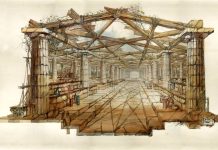What was the beauty of the ideal model? The idea that number is the key to understanding the universe and its structure was adopted by Plato from the Pythagoreans. For the first time, perhaps, they came to the conclusion that “the book of nature is written in the language of mathematics,” as Galileo formulated this idea two millennia later.
The numerical language of the Pythagoreans, formed by numbers and numerical relations, expressed the qualitative diversity of the unity of the world, understood in the spirit of a single musical harmony of the “music of the spheres”.
Plato’s Cosmos
Plato, believing that perfectly correct motion is circular motion, imagined the cosmos to consist of spheres nested one into another. At the same time, everything moves in Plato: the sky itself, whose movement is eternal and perfect, and the concrete that is inside the “concentric spheres”. In addition, this correctly rotating sky is for Plato at once a sensually perceived cosmos, that is, a universal body, perfectly organized, and a living being.
The architectural interpretation of the Pythagorean-Platonic tradition of understanding the world in professional thinking is the geometric principles of architecture – various “sciences of harmonic relations”, the theory of proportions, the canon of the “golden section” – all kinds of searches for quantitative, structural expression of harmony, unity, beauty.
According to Plato’s Timaeus, the concept of proportions as equality of relations has two aspects: numerical relations, as they are expressed in the harmonic intervals of the Greek musical scale -1, 2, 3, 4 and the relations of geometric figures equilateral triangle, rectangle, isosceles triangle, square and Pentagon – figures that make up the elements of five regular polyhedra.
For the Pythagoreans, numbers also had a visual image. They depicted numbers geometrically, distinguishing between linear, flat and solid numbers. So, they had one as a point, two as a line (two points), three as a plane, four as a pyramid body.
To clarify the essence of the Pythagorean concept of the unity of the world, it is necessary to reveal the main content of the so-called “Pythagorean sign”, or pentagram, traditionally considered a Pythagorean esoteric symbol. Therefore, the number was perceived as a kind of intermediary between man and nature. The Pythagorean sign was understood as a constructive beginning of the world, living and inanimate nature. These Pythagorean ideas about the mathematical foundation of the universe are justified in the writings of Plato.
Regarding the dodecahedron, a three-dimensional modification of the pentagon, or pentagram, Plato says in the Timaeus that “God defined it for the universe and resorted to it when he painted and decorated it.” This idea is further addressed by the mathematician from Bologna Luca Pacioli, author of the treatise “Divine Proportion” (1509), which contains the theory of geometric proportions, in particular, the rules of the golden section of the division of the segment in the extreme and average ratio. He praises the pentagon.
The Italian architect Giacomo Vignola, who was strongly influenced by Pacioli and through him the Pythagorean tradition, will give a pentagonal shape to the beautiful Caprarola castle near Viterbo. Through the geometry, the secret symbolism of the pentagram, the architectural composition is, as it were, attached to the harmony of being, and the creativity of the architect is likened to the divine.
Plato distinguishes between geometric figures as they are represented in the drawing, and “figures by themselves”, i.e. those that “can only be seen with the mind’s eye”. They are the “mathematical things” that, according to Aristotle, Plato distinguishes from numbers and which he considers intermediate, placing them between the world of the ideal and the sensual world.
It is noteworthy that “mathematical”, according to Plato, are not the objects that arithmetic deals with numbers, but geometric shapes: circles, triangles, quadrilaterals and their fragments: radii, angles, diagonals, etc. Plato also includes stereometric (three-dimensional) shapes: cube, tetrahedron, octahedron, icosahedron, etc. He attributes the shapes of the four regular polyhedra to the particles that make up the elements of matter (earth, fire, air and water).
In the era of the dominance of Newtonian science, when the concepts of mass and force became the basic concepts of physics and when the structural aspects of the structure of matter receded into the background, this constructive idea of Plato began to seem artificial and fantastic. But it was completely natural for Plato with his structural-geometric mindset inherited from the Pythagoreans.
In our time, Plato’s hypothesis about regular polyhedra seems naive, but far from as ridiculous as it might have seemed 200-300 years ago or even in the last century. In modern concepts of the structure of matter, the regularities of the geometric structure and the problems of symmetry associated with them are of paramount importance.




















